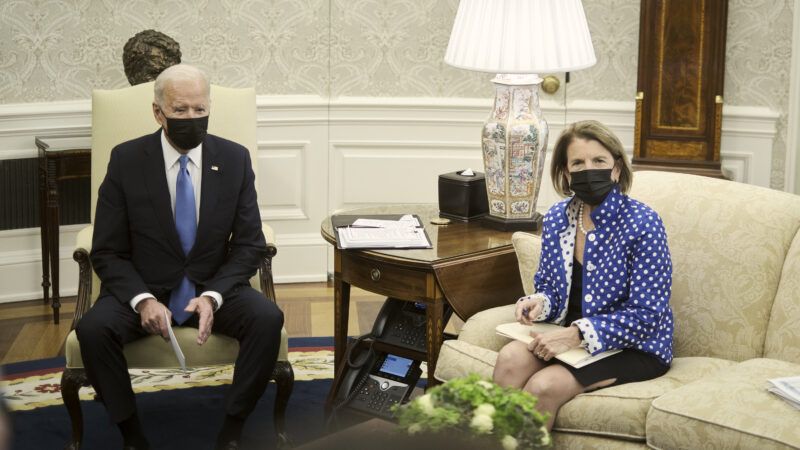Senate Republicans Released a $928 Billion Infrastructure Plan. Biden Says It Still Doesn't Spend Enough.
For the president, the spending is the point.

For the last several weeks, President Joe Biden has been negotiating an infrastructure spending proposal with a select group of Senate Republicans, hoping to find a plan that can garner bipartisan support. In the process, Biden has revealed how little he cares about infrastructure per se and how much he cares about spending for its own sake.
Biden started with a plan that would cost about $2.3 trillion, give or take. After Republicans said the topline figure was too high, he released a follow-up offer that brought the total down to around $1.7 trillion. Republicans started with a $568 billion proposal, and yesterday released a counteroffer for $928 billion in infrastructure spending.
Even the Republican counterproposals are massive sums by any measure, but for Biden they are still not enough. Shortly after Republicans released their plan yesterday, the Biden administration responded by complaining that it did not represent enough new spending, because much of it would be paid for by redirecting unspent funds from previous COVID relief bills.
The GOP counteroffer was an improvement, White House spokesperson Jen Psaki said. But it "still provides no substantial new funds for critical job-creating needs."
The key phrase there is "new funds." Of the $928 billion, Axios reports, about $257 billion would come from new spending; the rest would come from repurposed funds, such as earlier pandemic relief bills where the money has not been fully spent.
Republicans, in other words, not only proposed nearly $1 trillion in spending on a constellation of projects that Biden says are a priority; they found ways to offset the cost of much of it by redirecting unused money. You might think Biden would be interested in backing that, since it funds his priorities in a way that required less federal funding. Yet his administration complains that the proposal doesn't have enough new spending.
The spending is the point, almost entirely apart from how the money is spent or what projects it produces. The president is not just concerned about obtaining funding for specific infrastructure projects or programs; he wants to spend money just to have spent it.
That drive to spend—and spend and spend and spend—is how we ended up with a nearly $2 trillion coronavirus relief bill that had little to do with the coronavirus. It is how Biden stuffed his initial infrastructure proposal with what amounted to a lump-sum payout to a friendly labor union. It is how he arrived at a budget proposal that would push annual spending to new peaks while relying on near-record levels of borrowing. And it is why Treasury Secretary Janet Yellin gave a speech this week complaining that even after the roughly $6 trillion in pandemic-adjacent spending that was tacked onto the federal budget over the last year or so, Congress simply wasn't spending enough. It's all part of a push to permanently enlarge the scale, scope, and spending of the federal government.
It's already costing us even more than planned: According to the Congressional Budget Office, the deficit-financed $1.9 trillion relief bill Biden signed earlier this year will actually cost more like $2.1 trillion once a little more than $200 billion worth of interest payments are factored in. It's costing taxpayers money to spend money. Expect a lot more of that in the months and years to come.


Show Comments (104)